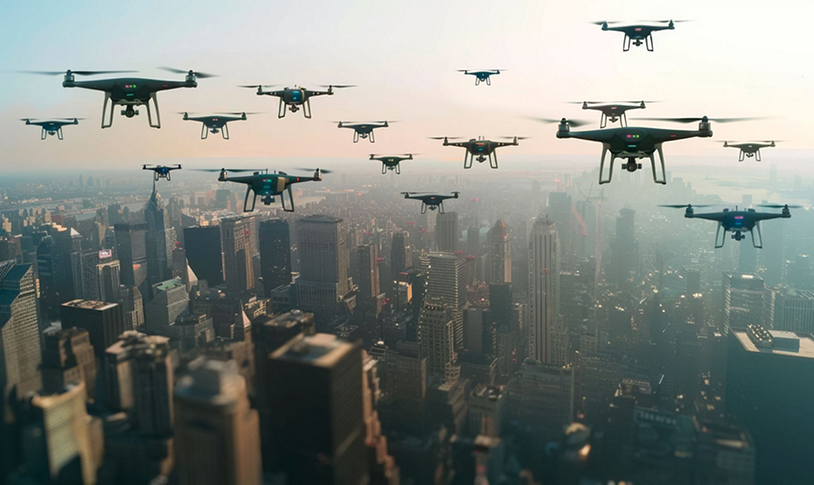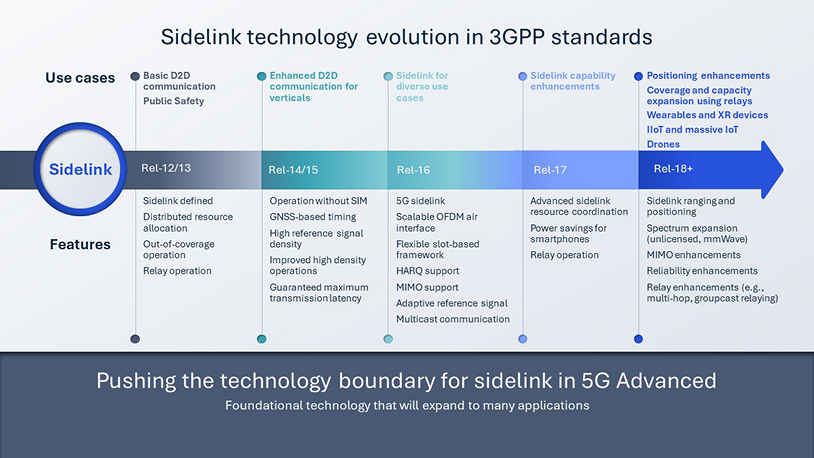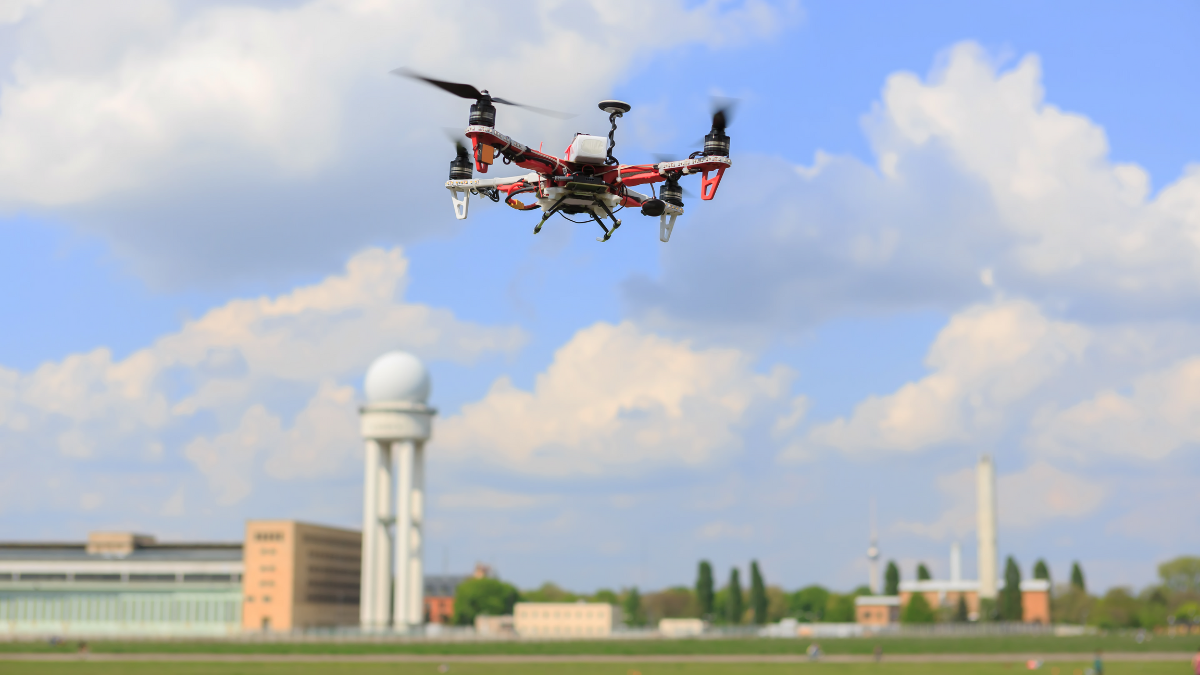Network-independent drone-to-drone communications are key to safe and efficient flights in the national airspace
Pitney Bowes estimates that about 59 million packages are delivered every day in the U.S.1 If 50% of those deliveries were done by drones, that would require nearly 30 million drone flights each day. This is one of many scenarios that may become a reality in the not-so-distant future with the proliferation of low-flying drones. A collision avoidance technology called Aircraft-to-everything (A2X) can help ensure those drone flights are safe and efficient.
The benefits of low-flying drones (i.e., drones flying no higher than 400 feet above ground level) are plentiful and transformative. Along with delivering packages, they can deliver critical medical supplies and aide in the inspection and monitoring of critical infrastructure like pipelines, power lines, roads and bridges. Drones also can provide meaningful public safety benefits by providing post-natural disaster assessments, surveilling hazardous situations, and supporting public safety personnel with search, rescue and investigation tasks. There also are economic benefits to the proliferation of drones: ABI estimates current revenues generated by the commercial small drone market will reach $8.7 billion by 2026 and $12.4 billion by 2028.2
To realize these benefits, drone operations must be safe and scalable. Collision management of drones and obstacle avoidance (for both fixed and temporary obstacles) must be addressed on two fronts to prevent dangerous in-flight collisions. The first is strategic deconfliction, which includes the planning and coordination aspects of a flight and — where network connectivity is available — real-time flight monitoring and plan modifications. Work is already underway at the Federal Aviation Administration (FAA) to develop strategic unmanned aircraft system (UAS) traffic management systems (UTM) that address this first component, which leverages real-time beyond visual line of sight (BVLOS) communications between drones and UTM.
However, as low-flying drone operations begin to scale, UTM services alone won’t be able to successfully manage safe drone operations in heavily congested airspace with large concentrations of drone flights occurring simultaneously. For instance, UTM services may not timely address the evasion of unforeseen flying objects or may fail to react in real-time when a drone suddenly faces technical difficulties and needs to land immediately in a busy transportation corridor. UTM services also will face limitations when network connectivity is unavailable, overloaded or severely degraded, or when drones in potential conflict are administered by different UTM service providers.
As a complement to UTM services, tactical deconfliction is required to address imminently detected collisions. A2X can provide detect and avoid communications, supporting tactical deconfliction for drones without network connectivity.
A2X communications can enhance aviation safety and enable more efficient flights in our national airspace. To realize this, we need dedicated spectrum for drone-to-drone communications. We call on the FCC to allocate a 20 MHz channel in the 5030 MHz band, which has been identified globally for aviation operations, to support A2X applications in the U.S.
A2X communications must be a key means of ensuring safe UAV flights
A2X is a technology that enables direct drone-to-drone communications, without satellite or cellular connectivity, for collision avoidance among multiple drones, or between drones and other A2X-enabled obstacles. The information exchanged between drones within range of one another — including drone altitude, speed, trajectory and location — enables them to detect and avoid colliding with each other. Allowing drones to constantly talk to one other via A2X enhances situational awareness of the surrounding risks and improves drone safety and functionality.
A2X is ideal for ensuring safe flights in BVLOS scenarios, where the pilot’s visual awareness of the drone is unavailable and where the command-and-control link (i.e., the communications link used to monitor and control the drone) is spotty. Because A2X is independent of network connectivity, resources like timing/configuration from the network are not necessary for a drone to determine its position relative to other drones. A2X uses timing and positioning provided by Global Navigation Satellite Systems (GNSS). And even if GNSS connectivity is unavailable, a drone can use ranging to determine the distance between itself and other drones to avoid in-air collisions.
A2X-equipped drones broadcast basic safety messages to other drones over several kilometers in real-time, providing low-latency communications, on the order of single-digit milliseconds. Thereby, drones can quickly recognize and avoid each other in areas with heavy air traffic, where drones are flying at vastly different speeds, altitudes and trajectories. A2X also allows drones to communicate directly with each other using a unicast channel to resolve potential conflicts.
As a complementary technology to UTM services, A2X provides a necessary backstop at low altitudes, where drone operators typically face topographical and other line-of-sight challenges. A2X provides localized detect and avoid communications during routine, exigent and unplanned flights, so if the command-and-control link goes down, drones can continue to maintain a safe distance from each other. Beyond collision avoidance, A2X also can coordinate traffic separation in a variety of shared airspace environments, including around airports.
Scalability is baked into A2X technology. Consistent with 3GPP cellular standards that have a history of seamlessly connecting millions of devices simultaneously, A2X can support millions of drones at a given time within the continental U.S. A2X can support this while providing low-latency communications in dense operating environments, guaranteed quality of service, and interference management.
Achieving scalability, while maintaining safety, is key to realizing the public interest and economic benefits of drone operations. A2X can meet this need and ensure safe and efficient drone operations in shared airspace.
While there are alternative solutions for network-independent communications, none carries the promise of A2X. Radar solutions for drone operations are heavy and costly for collision avoidance, impacting widespread deployment particularly with small drone operations that are expected to proliferate over the coming years. Automatic Dependent Surveillance-Broadcast (ADS-B) technology is not geared for the anticipated scale at which drone operations will grow, which may overwhelm the supporting infrastructure and affect reliability. This issue also can impact situational awareness of the surrounding risks for drone operations.

A2X was developed in 3GPP
A2X was developed through the third-generation partnership project (3GPP) under the foundational technology called sidelink. 3GPP specifications are open, thereby promoting interoperability and fostering innovation. A2X standardization through 3GPP facilitates widespread adoption of the technology by enabling inter-vendor system interoperability, so equipment manufacturers can reach economies of scale, resulting in lower deployment costs. Standardization also encourages new entrants at every vertical of the supply chain to innovate and compete successfully.
Additionally, 3GPP specifications are not static. Through the close collaboration of hundreds of companies representing different industry verticals, specifications are developed and continuously refined. This iterative process allows for continuous improvement and the creation of innovative applications and products. As a 3GPP-enabled technology, A2X will be continuously refined through this iterative process.
A2X’s foundational technology is being successfully deployed worldwide for vehicle roadway safety: Cellular-vehicle-to-everything (CV2X) supports direct vehicle communications to other vehicles, infrastructure and vulnerable road users, to enhance roadway safety. C-V2X is being deployed in the U.S., China, Europe, Korea and other countries.

Dedicated spectrum is needed for A2X
Because A2X-supported safety critical messages need to be received in real-time, it needs dedicated licensed (i.e., protected) spectrum. While some drone operators today are using unlicensed spectrum for drone-to-drone communications, this approach is not a long-term solution because it could have reliability problems in dense, scaled operating environments. Unlicensed spectrum lacks interference protection and is heavily used in urban areas for Wi-Fi connections and other uses where drone operations will commonly occur. Additionally, there is no guaranteed access to unlicensed spectrum.
Use of operator licensed spectrum has its drawbacks as well, because it does not allow for drones not on the carrier’s network to communicate with those that are.
A2X needs a common operating channel that drones can use to sense, transmit and receive safety-critical messages from other drones regardless of the carrier network the drones are using for other types of communications.
Qualcomm Technologies’ simulations have shown that a 20 MHz channel provides the appropriate balance of density and coverage, supporting safety-critical communications for 20 drones over 1.2 kilometers.3 The communications range is significantly reduced to 600 meters when using a 10 MHz channel. Additionally, the 20 MHz channel size is commensurate with the channel size used for C-V2X basic safety communications.
The 5030 MHz band (5030-5091 MHz) can be a home for A2X applications. The band has been identified globally for aviation operations, it has sufficient spectrum to support a 20 MHz A2X channel, and, as mid-band spectrum, it strikes an appropriate balance of coverage and capacity for dense drone operations. The Federal Communications Commission is considering a Report and Order that, if adopted, would allocate a portion of the 5030 MHz band for control non-payload communications. While this allocation is separate from A2X detect and avoid communications, the two can coexist in separate portions of the 5030 MHz band. The FCC should therefore consider an allocation of a channel for A2X in the future.
With the recent passage of the FAA Reauthorization Act of 2024, one provision of the law stands out: the timeline for the FAA to finalize rules to enable routine BVLOS operations. Many in the aviation industry view this proceeding as the key catalyst that will spur explosive growth of low-flying drone operations. Because of the rapidly evolving drone ecosystem, it is important to ensure drone operations are both safe and efficient. A2X is a 3GPP-enabled technology that can ensure safe flights in a limited shared airspace, while not compromising scalability or efficiency, so the public can reap the public interest and economic benefits of scaled drone operations.

